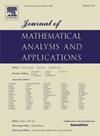关于达到规范的布洛赫映射
IF 1.2
3区 数学
Q1 MATHEMATICS
Journal of Mathematical Analysis and Applications
Pub Date : 2024-09-23
DOI:10.1016/j.jmaa.2024.128901
引用次数: 0
摘要
给定复巴纳赫空间 X,让 Bˆ(D,X)表示从开阔复单位圆盘 D 到 X 的所有归一化布洛赫映射的空间。我们将证明,Bˆ(D,X)中所有达到布洛赫规范的映射的集合在 Bˆ(D,X)中是规范密集的。我们的方法基于之前对 G(D)(D 上无布洛赫的巴拿赫空间)单位闭球极值结构的研究。我们证明,D 的归一化布洛赫原子正是该球的唯一极值点,事实上,它们是强暴露点。此外,我们还描述了涉及 D 的莫比乌斯变换的 G(D) 的投射线性等距。本文章由计算机程序翻译,如有差异,请以英文原文为准。
On norm attaining Bloch maps
Given a complex Banach space X, let denote the space of all normalized Bloch maps from the open complex unit disc into X. We prove that the set of all maps in which attain their Bloch norms is norm dense in . Our approach is based on a previous study of the extremal structure of the unit closed ball of (the Bloch-free Banach space over ). We prove that normalized Bloch atoms of are precisely the only extreme points of that ball and, in fact, they are strongly exposed points. Moreover, we characterize the surjective linear isometries of involved the Möbius transformations of .
求助全文
通过发布文献求助,成功后即可免费获取论文全文。
去求助
来源期刊
CiteScore
2.50
自引率
7.70%
发文量
790
审稿时长
6 months
期刊介绍:
The Journal of Mathematical Analysis and Applications presents papers that treat mathematical analysis and its numerous applications. The journal emphasizes articles devoted to the mathematical treatment of questions arising in physics, chemistry, biology, and engineering, particularly those that stress analytical aspects and novel problems and their solutions.
Papers are sought which employ one or more of the following areas of classical analysis:
• Analytic number theory
• Functional analysis and operator theory
• Real and harmonic analysis
• Complex analysis
• Numerical analysis
• Applied mathematics
• Partial differential equations
• Dynamical systems
• Control and Optimization
• Probability
• Mathematical biology
• Combinatorics
• Mathematical physics.

 求助内容:
求助内容: 应助结果提醒方式:
应助结果提醒方式:


